Corner Indices
Corner Indices were a major innovation in playing card production.
A patent was issued on February 9, 1864 to Cyrus W. Saladee of Paducah, Kentucky, under patent number 41,587. It is believed to be the first American deck with corner indices.
“My invention consists in combining a number or letter with an emblem - such as a heart, spade, club or diamond - so that upon seeing the emblem, which may be in a corner, the denomination of the card is at once understood.”
This idea revolutionized American card manufacture by enabling players to fan the cards to view only the corner of each card, sufficient to see the indices. This was soon followed by Andrew Dougherty’s patent for “Triplicates” and other novel systems of index types which were adopted by other manufacturers until, over time, they became the new norm.
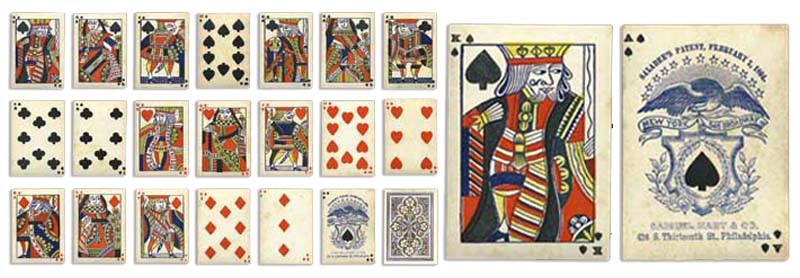
Above: Saladee's patent deck with small corner indices published by Samuel Hart, Philadelphia, 1864. The Ace of Spades mentions Saladee’s name. Hart also issued a “Bazique” set incorporating two Saladee Bazique Registers►
Triplicates
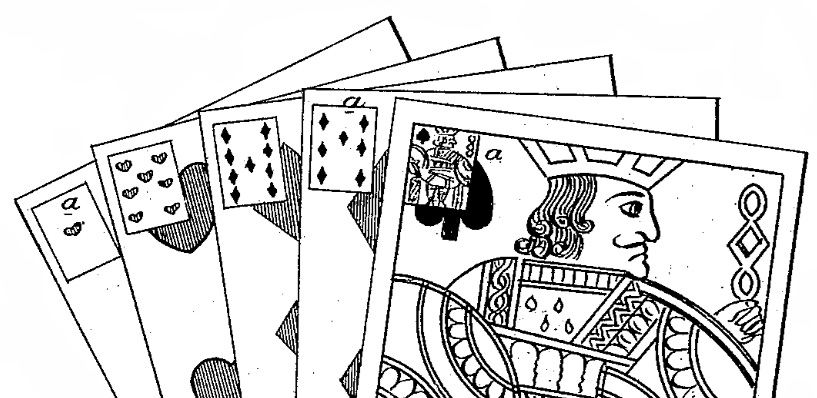
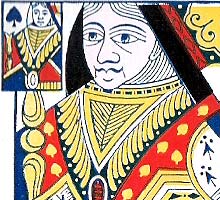 Andrew Dougherty first secured a patent for “Triplicates” in 1875, a novel type of indices with a miniature card in the top left-hand corner (and bottom right). These kept Dougherty at the forefront of innovation. There are several variations in the size and design of the “Triplicate” indices, with the smallest being the earliest. Dougherty's “Triplicates” have a specially designed Ace of Spades with a spread of cards inside the central Spade symbol demonstrating the innovation.
Andrew Dougherty first secured a patent for “Triplicates” in 1875, a novel type of indices with a miniature card in the top left-hand corner (and bottom right). These kept Dougherty at the forefront of innovation. There are several variations in the size and design of the “Triplicate” indices, with the smallest being the earliest. Dougherty's “Triplicates” have a specially designed Ace of Spades with a spread of cards inside the central Spade symbol demonstrating the innovation.

Above: Triplicate No.18' playing cards by Andrew Dougherty, c.1878. This is the second version of the brand with a 'Little Joker' card instead of a 'Best Bower' and a more elaborate Ace of Spades with the addition of two cherubs and an eagle at the top. Image courtesy Rod Starling.
In 1876, the year after Dougherty, Robert Chanony of France patented the same idea. Patent number US182166►
“The object of my invention is to improve playing-cards by rendering it possible for players to distinguish the cards in their hands without exposing them ... and this I accomplish by combining with each card one or more miniature representations thereof, as shown in the accompanying drawing.”

Above: following the lead of American manufacturers such as Dougherty and New York Consolidated Card Company, Willis & Co. introduced novel types of miniature corner indices to facilitate fanning or 'squeezing' the cards during the mid-1880s. The miniature 'triplicate' cards in the corners were apparently registered, and are ¾ or full-length figures. Interestingly the mini court indices are full length courts but Willis appeared never to manufacture full length court cards.
Indicators
Dougherty’s innovations include adding Best Bowers, Jokers, rounded corners and introducing various novel types of indices to his cards. In 1883 he was granted a patent for numbered indices, or “Indicators”, printed outside the border, along with the earlier form of “Triplicates”. It also has small breaks in the borders, as in Spanish cards, (see earlier patent for this) and these innovations helped players distinguish cards by only peeping at the corners.
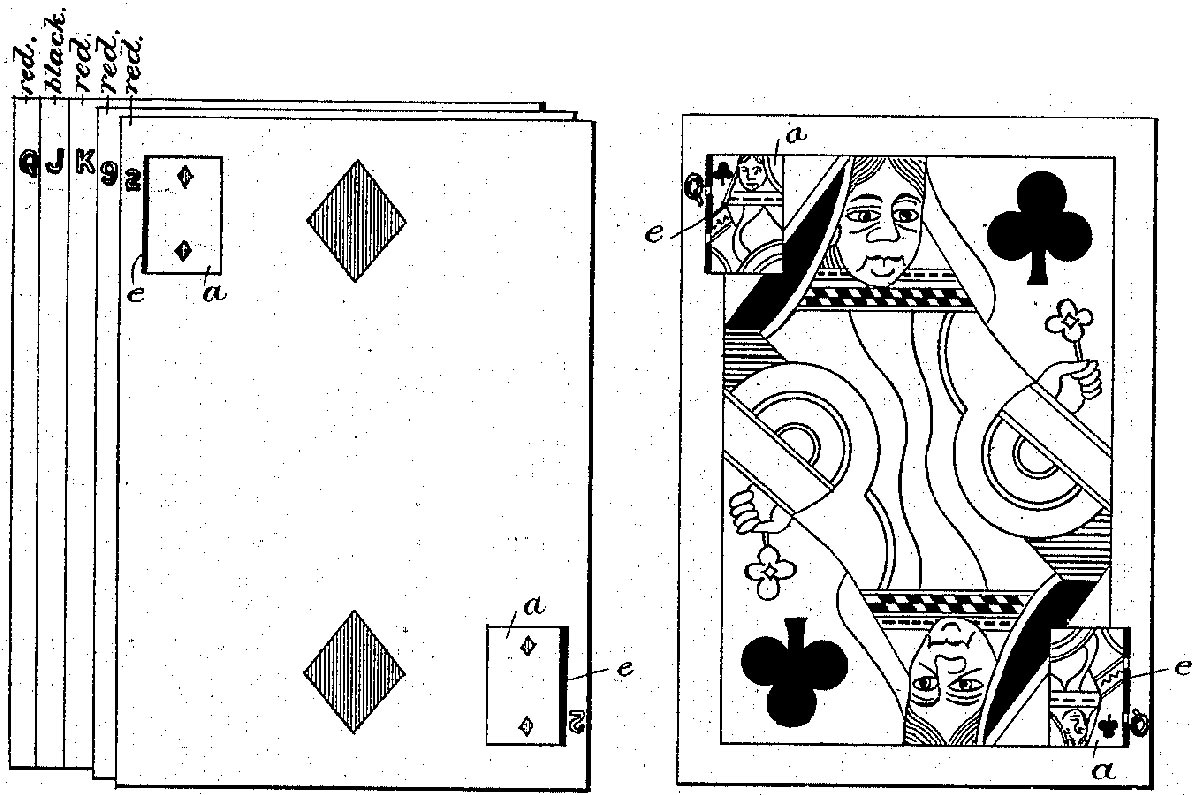
Above: details from Andrew Dougherty’s 1883 patent for Indicators see more →
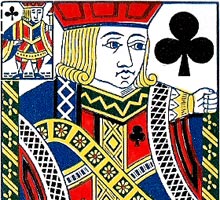
Above: “Triplicates”, the miniature cards in the corners, with little breaks in the border, which had been patented in 1876►
These “Indicators”, printed outside the border, soon became standard.

Above: Dougherty's “Ivorette No.70” deck has the “Indicator” Ace of Spades and a Jolly Joker. The Ace of Spades mentions two patents, the earlier date being for the first “Triplicate” format and the second date being for the addition of the indicator number. It was the last of the Triplicate series and incorporated the first use of numbered indices. The small margin breaks in the miniature playing cards differentiate the suits. It only ran for a year or less and was followed in 1894 by Indicators No.50. Image courtesy Rod Starling.
Many brands were issued featuring these new “Indicators”. The main distinguishing feature was the box. Brands include “Ivorette”, “Tudor”, “Tandem”, “Mogul”, “Sunset” etc.
Regarding Dougherty's “Indicator” indices that were patented in 1883, that would have been just six years after NYCCC obtained its own patent for “Squeezers”, which are more or less the same idea. It is difficult to understand what difference there was between NYCCC's “Squeezers” and Dougherty's “Indicators” that would warrant each company being granted patent rights at about the same time.
Similar new ideas were being introduced or imitated simultaneously by other manufacturers both in USA and elsewhere, with various different patented brand names, such as “Squeezers”, “Dexters”, “Eureka”, etc. so that the corner indices we now take for granted were born from these competing innovations.
The Muir & Moodie Photography Studio (1898-1916) published post cards and other photographic items documenting events in New Zealand daily life. The playing cards shown here, described on the extra card as the Greatest Novelty of the Century, feature “Triplicate” indices and corner pip arrangements on the numeral cards. The cards were printed in Bavaria (Germany) for export to New Zealand where they were sold.
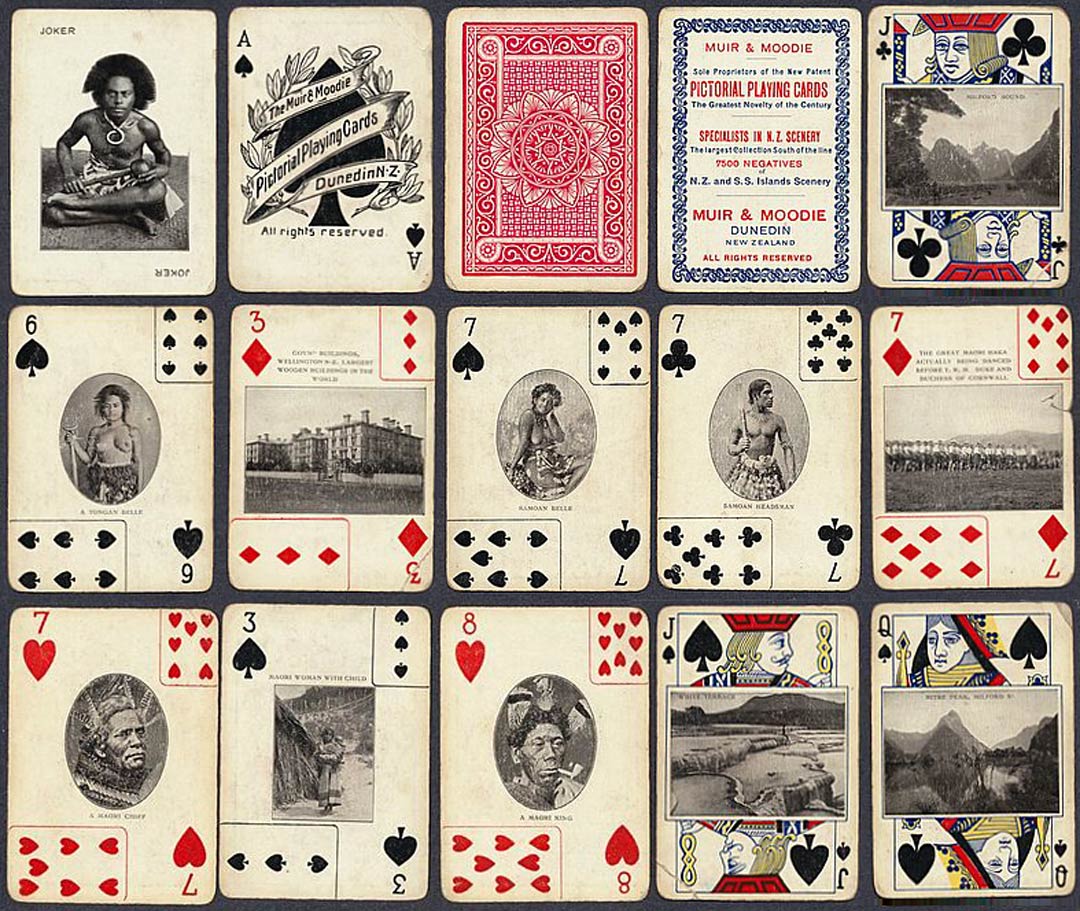
Above: The Muir & Moodie Pictorial Playing Cards, published by Muir & Moodie (1898-1916), Dunedin, New Zealand, c.1903. There was an import duty which usually has a stamp on the 2 of Diamonds. Images kindly supplied by Jack Berkus.
Dexters
The "Dexter indexes" are interesting in that the suit-signs in the corners bear a number in white upon them; the 2s and 3s have had their pips moved to accomodate this scheme. The corners of the Aces bear the outline of the respective suit, in which is the word ‘ace’. There is no marking of any sort on the Ace of Spades. The suit signs on the courts bear the letters ‘Kg’ on a King, ‘Qn’ on a Queen, and a ‘Kn’ (shorthand for "Knave") on a Jack. The original Dexter indices placed inside the corner pips had several variants: ‘Kn’ or ‘J’ for Jack; two arrangements of Aces, twos and threes; and ‘1’ or ‘ace’ on the Aces. This type of index was introduced in around 1878 and continued until c.1890. There are no jokers in this edition.
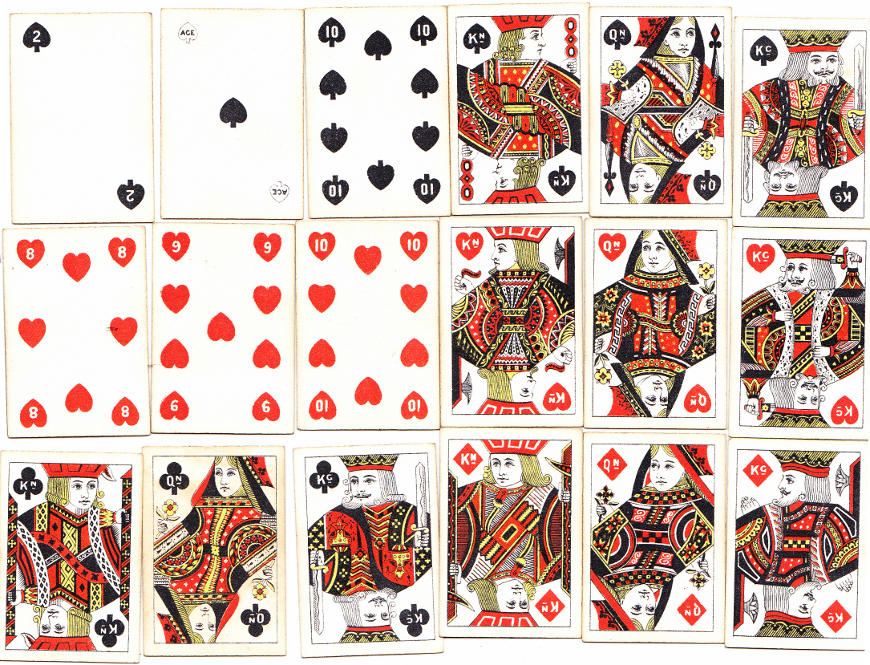
Above: 'Pigmy' miniature double-ended playing cards with 'Dexter' indices manufactured by Thomas De la Rue, c.1890. The cards measure 3 x 4.5 cms. Images courtesy Anthony Lee.
Eurekas
Packs with corner indices, along with rounded corners, had been introduced by Woolley & Co as a novelty around 1878-79 and were sold at that time for one shilling per pack. There were two versions: one with diagonal twos and threes, the other with vertical twos and threes, with small corner indices as on the ace of spades. Sometimes the AS doesn’t have an index. Both Woolley and De La Rue retained the original names for their indices after they had changed to ordinary ones. Palace Gold Dexter Moguls were still being advertised in 1931.
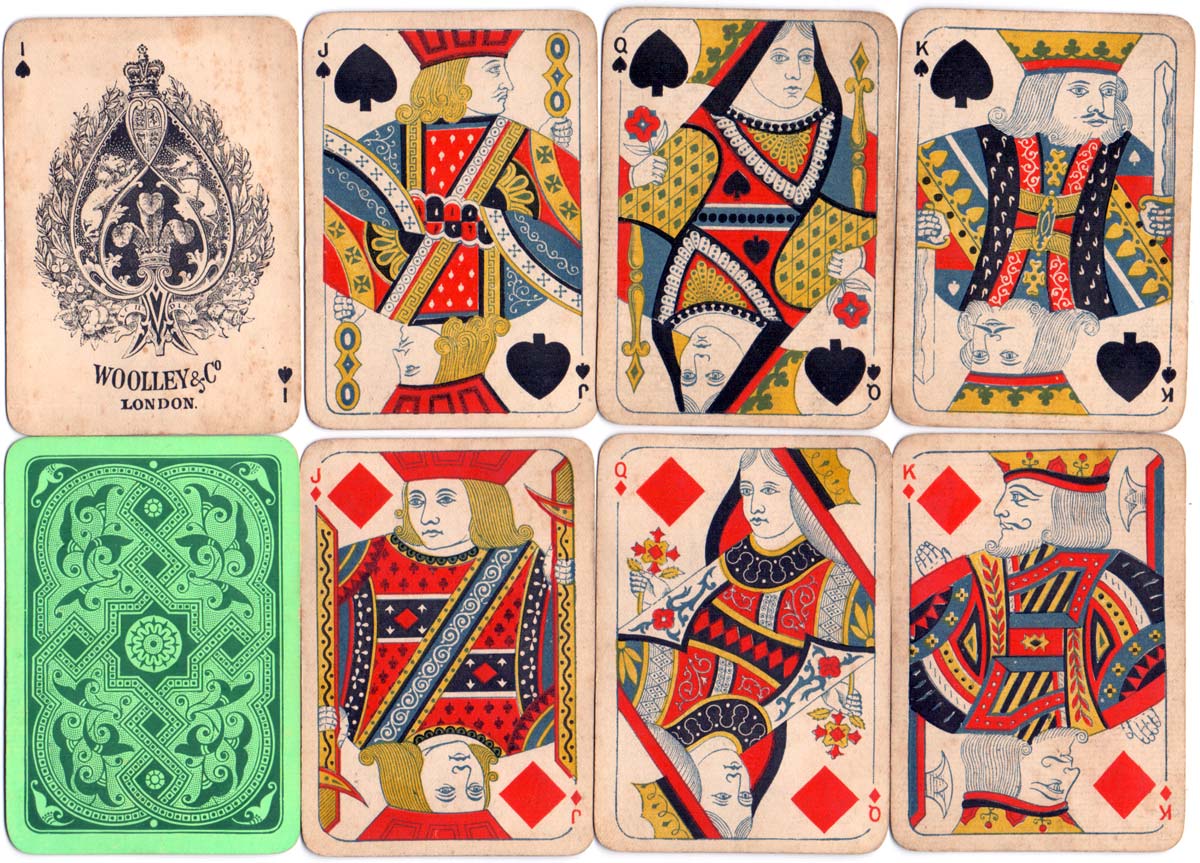
Above: Woolley & Co “Eureka” playing cards with rounded corners, small index pips and green decorative back design, c.1880-1885.

Above: very small indices with '1' for the ace, De la Rue, c.1885-1890. Courtesy Matt Probert. (Click to zoom)
Hand-drawn indices
Right: during the period c.1870-1890 indices were being introduced on playing cards. Packs are sometimes found with hand-written indices where players have improvised in interesting ways, providing documentary evidence of the days when corner indices were still in their infancy.
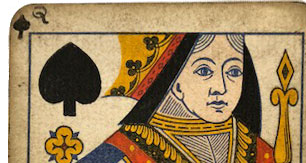
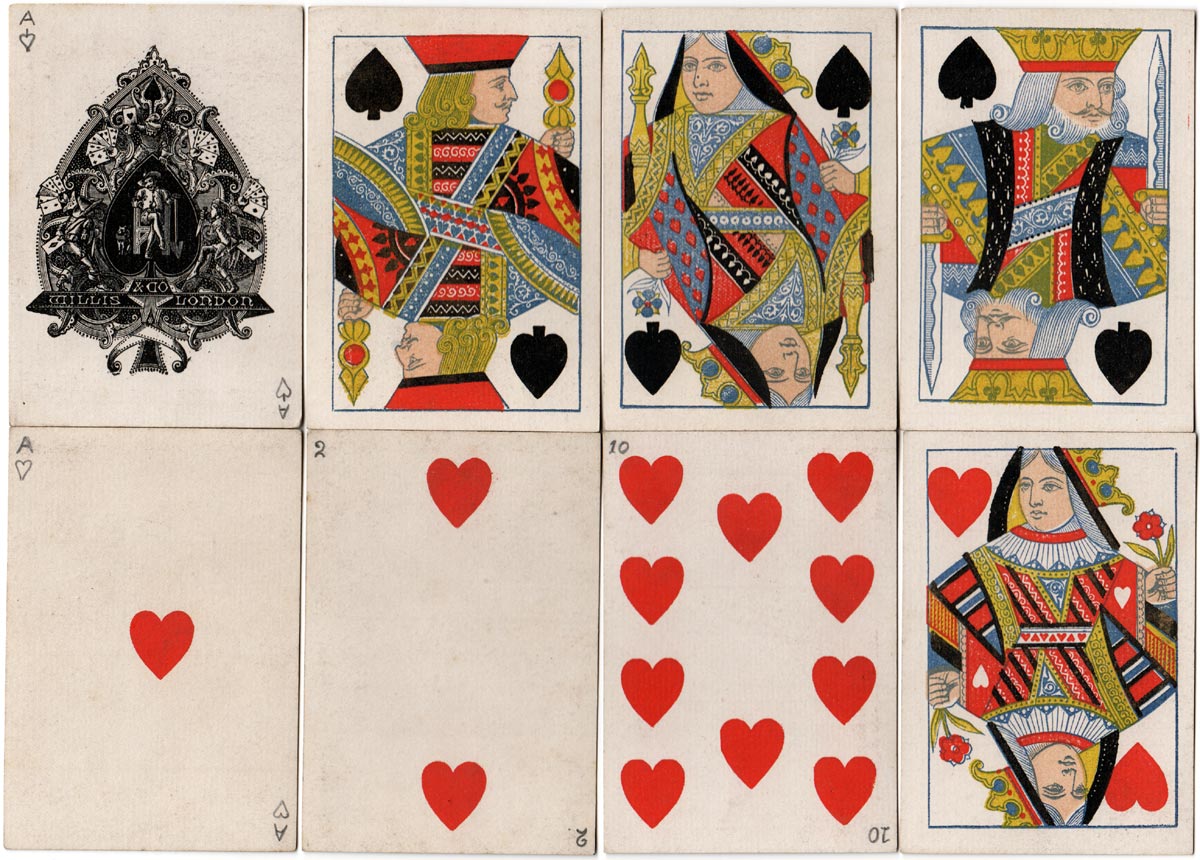
Above: cards by Willis & Co., c.1875, square corners, no indices but with small 'Eureka' indices neatly pencilled in the corners of numeral cards by a previous owner, providing documentary evidence of the days when corner indices were still in their infancy.
Footnote: Tarock games are known for having a unique card hierarchy and scoring system that differs from standard card games. Where a rank order such as A, K, Q, J, 10... might be the norm, Tarock decks often have a non-linear ranking and special scoring values. Players accustomed to conventional trick-taking games might find the Tarock system confusing or difficult to remember. To make life easier players might make manual alterations to the cards, such as adding numerical values and clarifying the ranking. This gives us a glimpse into the pragmatic ways in which people adapted games to suit their needs in an era before mass-produced, standardized card sets.
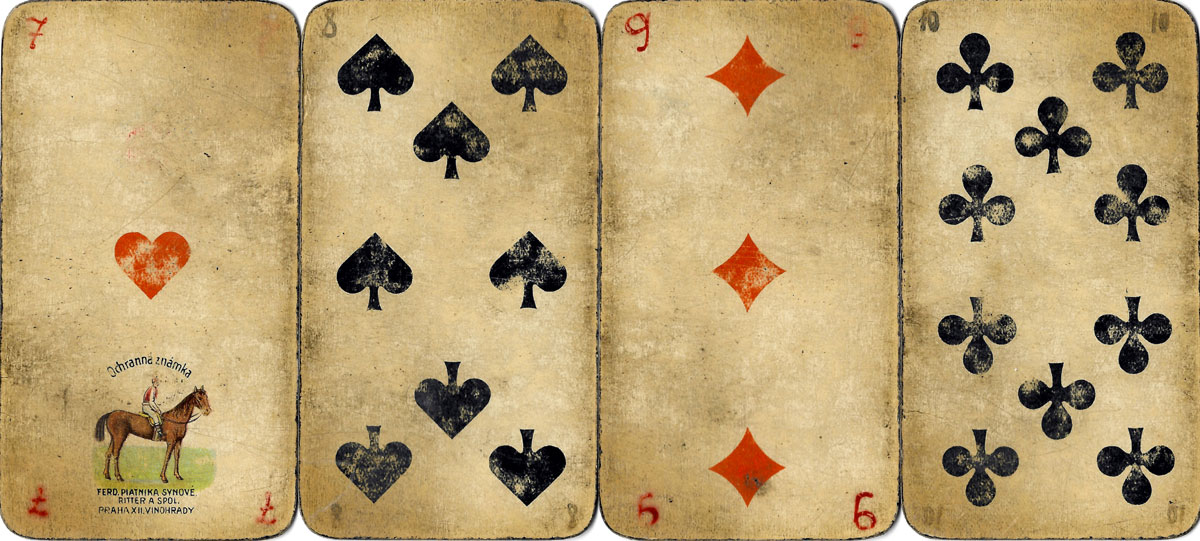
REFERENCES
Dawson, Tom & Judy: The Hochman Encyclopedia of American Playing Cards, U.S. Games Systems Inc., 2000
Thanks to Ken Lodge, Marek Brejcha and Matt Probert for additional research.
By Simon Wintle
Spain • Member since February 01, 1996 • Contact
I am the founder of The World of Playing Cards (est. 1996), a website dedicated to the history, artistry and cultural significance of playing cards and tarot. Over the years I have researched various areas of the subject, acquired and traded collections and contributed as a committee member of the IPCS and graphics editor of The Playing-Card journal. Having lived in Chile, England, Wales, and now Spain, these experiences have shaped my work and passion for playing cards. Amongst my achievements is producing a limited-edition replica of a 17th-century English pack using woodblocks and stencils—a labour of love. Today, the World of Playing Cards is a global collaborative project, with my son Adam serving as the technical driving force behind its development. His innovative efforts have helped shape the site into the thriving hub it is today. You are warmly invited to become a contributor and share your enthusiasm.

Leave a Reply
Your Name
Just nowRelated Articles

English Pattern by B.P. Grimaud
Standard English pattern published by B.P. Grimaud with engraving by F. Simon, c.1880.

Archaeological find: old playing cards under the floorboards
The municipal archaeological service in Dordrecht (Netherlands) recently found some antique playing ...
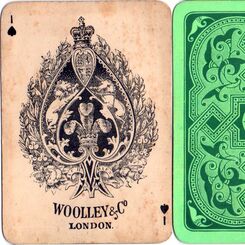
Woolley & Co: “Eurekas”
Woolley & Co: “Eureka” playing cards with rounded corners, small index pips and decorative back desi...
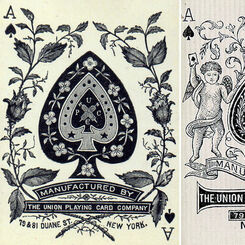
Union Playing Card Co.
Not much is known about this early manufacturer who is reckoned to have traded between c.1860s-1890s...

Triplicate No.18
Dougherty first secured a patent for “Triplicates” in 1876, a novel type of indices with a miniature...
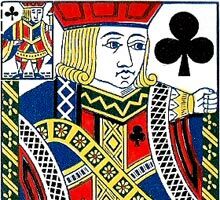
Ivorette
Dougherty was at the forefront of innovation, adding Best Bowers and then Jokers, rounded corners an...
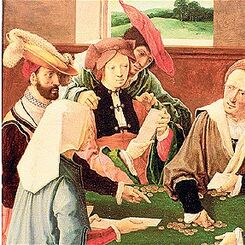
Netherlands
Playing cards have been known in the Low Countries since the 14th century
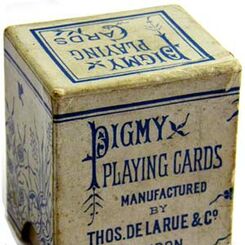
Pigmy Playing Cards
Pigmy Miniature Playing Cards
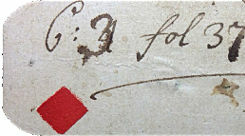
Secondary Uses of Playing Cards
The unprinted backs of playing cards have led people to use them for secondary purposes such as memo...
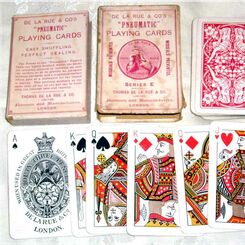
Pneumatic Playing Cards
The surface of the cards was slightly grooved by being rolled on prepared plates, so that there were...
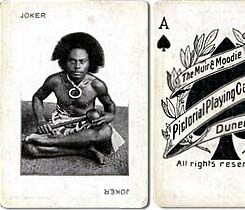
Muir & Moodie’s Pictorial
Muir & Moodie’s Pictorial playing cards, New Zealand, c.1903
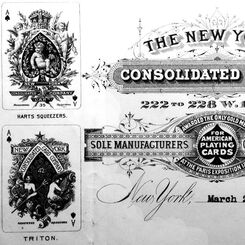
New York Consolidated Card Company
The New York Consolidated Card Company was formed in 1871 by the merging of Lawrence & Cohen, Samuel...
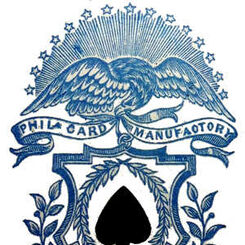
Samuel Hart, 1846-1871
Samuel Hart was a prolific manufacturer of playing cards who commenced business sometime around 1845...
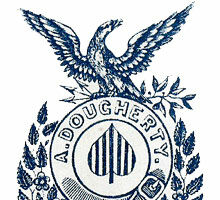
Andrew Dougherty 1848-1930
Andrew Dougherty was born in Donegal in Northern Ireland in 1827. He started his playing card busine...
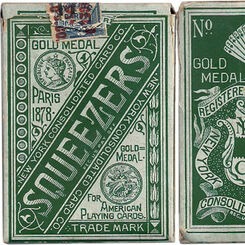
Squeezers No.35
By 1877 the New York Consolidated Card Co's "Squeezers" were a great success on account of the indic...
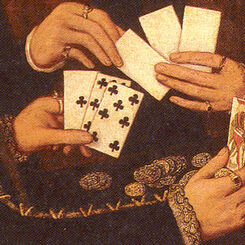
History of Blackjack
Over the years the origin of Blackjack, like many other games, has eluded researchers for a long tim...
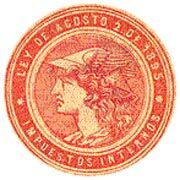
Argentina Tax Stamps on playing cards 1895-1968
Argentina Tax Stamps on playing cards 1895-1968
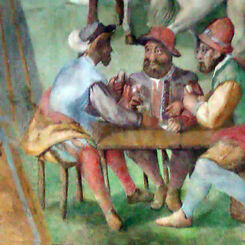
Italian Playing Cards
The first reliable evidence that playing cards were being used in Italy is from 1376, when a game ca...
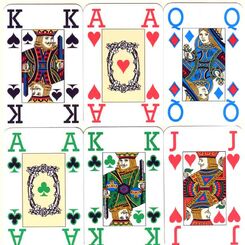
John Newman’s Colour Cards
John Newman’s Colour Cards

History of English Playing Cards & Games
The History of English Playing Cards dates probably from the mid 15th century
Most Popular
Our top articles from the past 60 days


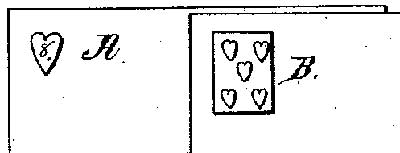
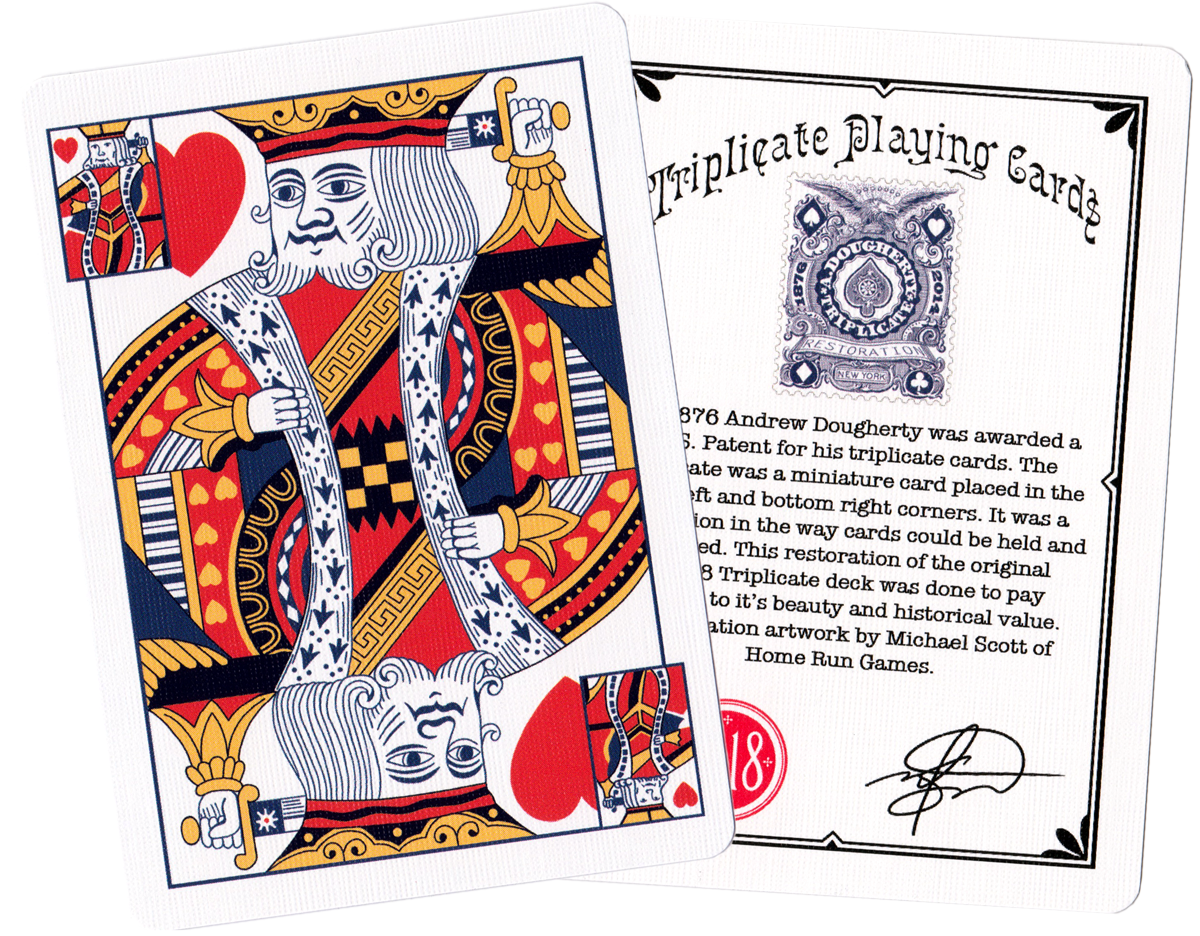
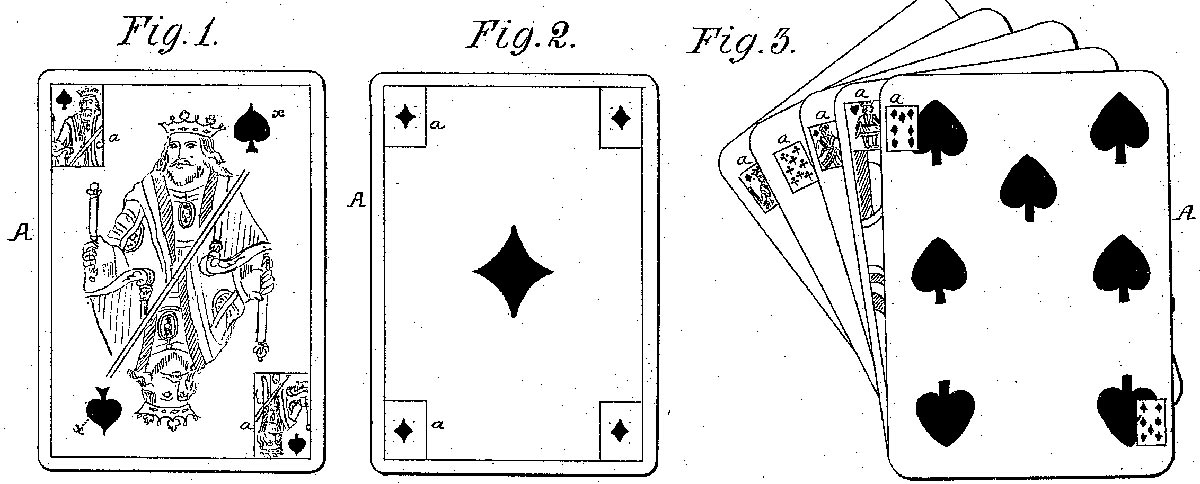

 Your comment here. Your comment here. Your comment here. Your comment here. Your comment here. Your comment here. Your comment here. Your comment here. Your comment here. Your comment here. Your comment here. Your comment here. Your comment here. Your comment here. Your comment here. Your comment here. Your comment here. Your comment here. Your comment here. Your comment here. Your comment here. Your comment here. Your comment here. Your comment here. Your comment here. Your comment here. Your comment here. Your comment here. Your comment here. Your comment here. Your comment here. Your comment here.
Your comment here. Your comment here. Your comment here. Your comment here. Your comment here. Your comment here. Your comment here. Your comment here. Your comment here. Your comment here. Your comment here. Your comment here. Your comment here. Your comment here. Your comment here. Your comment here. Your comment here. Your comment here. Your comment here. Your comment here. Your comment here. Your comment here. Your comment here. Your comment here. Your comment here. Your comment here. Your comment here. Your comment here. Your comment here. Your comment here. Your comment here. Your comment here.




















